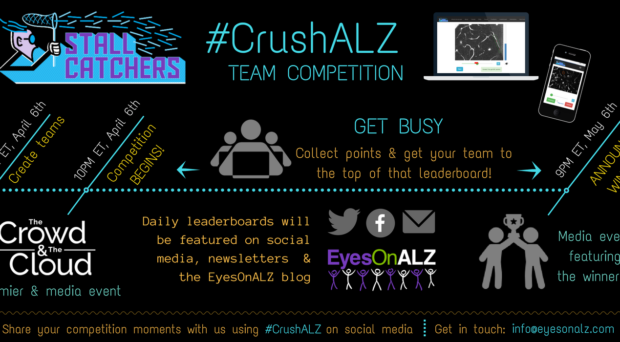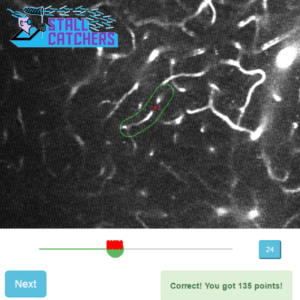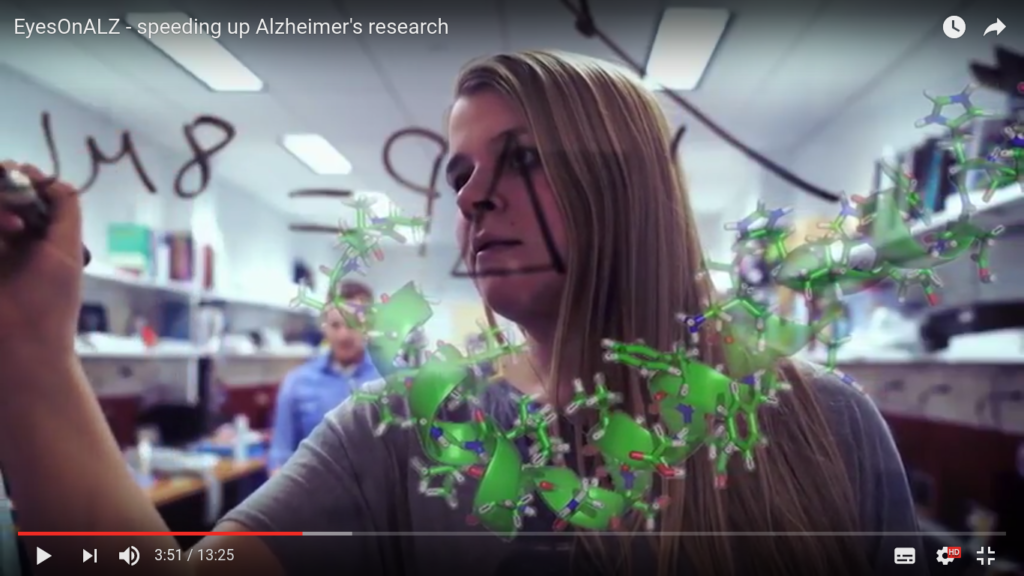
Stall Catchers is an online game that aims to speed up Cornell University’s groundbreaking AD research. This research, conducted in the Schaffer-Nishimura Lab, tries to understand the role of reduced brain blood flow found in AD patients. In Stall Catchers, participants analyze movies of a live mouse brain to identify “stalls” – blocked capillaries where blood is not flowing.

Stall Catchers is the first citizen science game to tackle AD. The game was launched in October, 2016, and currently has over 4,000 participants, ages 8 to 88. Stall Catchers aims to empower everyone – including families, caregivers and Alzheimer’s patients themselves to directly fight a disease that affects them and their loved ones.
EyesOnALZ and Stall Catchers are featured in Episode 1 of The Crowd & The Cloud mini-series about citizen science, which premiered on National Public Television across the US on April 6th, and is available to watch online at https://crowdandcloud.org.

This documentary series, created by a producer of Carl Sagan’s original COSMOS series, shines first light on a growing movement of citizens participating en masse in the advancement of scientific research. The creators of this 4-part mini-series are dedicated to “turning viewers into doers” by encouraging hands-on participation in science.
The Stall Catchers team competition to #CrushALZ kicked-off during the live streaming after-show event of The Crowd & The Cloud, and in the first hour as many as 1500 vessel movies were analyzed, climbing to three thousand over the next three hours. This number of vessels takes almost three weeks to analyze in the lab. Even taking into account that 20 crowd answers are currently needed to get a single expert-like answer, the crowd is already analyzing the data ten times faster than in the lab!
During the first three days of competition, 15 teams analyzed over 30 thousand vessels, analyzing almost 5% of the overall vessels needed to answer the current research question, which looks at the link between stalls and the locations of amyloid plaques in the brain of mice with AD.
Using the traditional laboratory-based analysis, it would take over a year to answer this question. So this is a major boost to the research carried out at Cornell, which, according to EyesOnALZ biomedical collaborator Chris Schaffer, “would be impractical without Stall Catchers”.
To make sure the research goal is achieved by the end of the month-long competition, Stall Catchers still needs more eyes. EyesOnALZ invites everyone to join or create a team on Stall Catchers for their organization (complete instructions can be found here). Daily results are reported & the most active teams are featured on the EyesOnALZ blog (see links to all reports here), EyesOnALZ social media channels, and those of partnering organizations.
The competition will run for one month, concluding at 9pm, ET May 6 / 1pm UTC, May 7.
This innovative approach to Alzheimer’s research had been funded by the BrightFocus Foundation (the official society of Molecular Neurodegeneration).
Egle Marija Ramanauskaite
Latest posts by Egle Marija Ramanauskaite (see all)
- Citizen science game is running a competition to accelerate Alzheimer’s research - 19th April 2017
- The Crowd: our newest weapon in the fight against Alzheimer’s - 15th November 2016
Comments